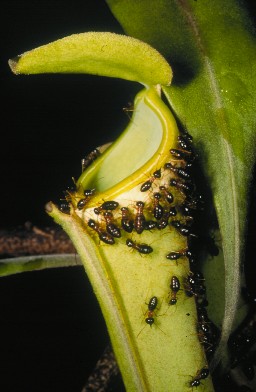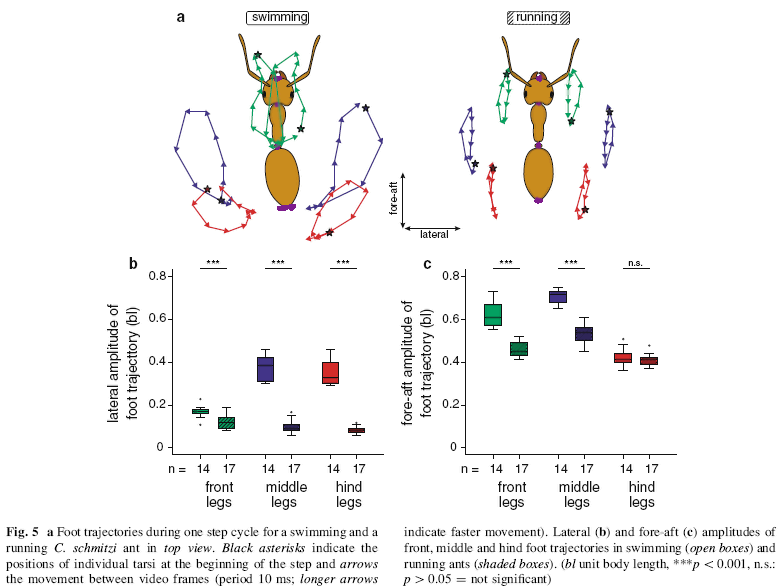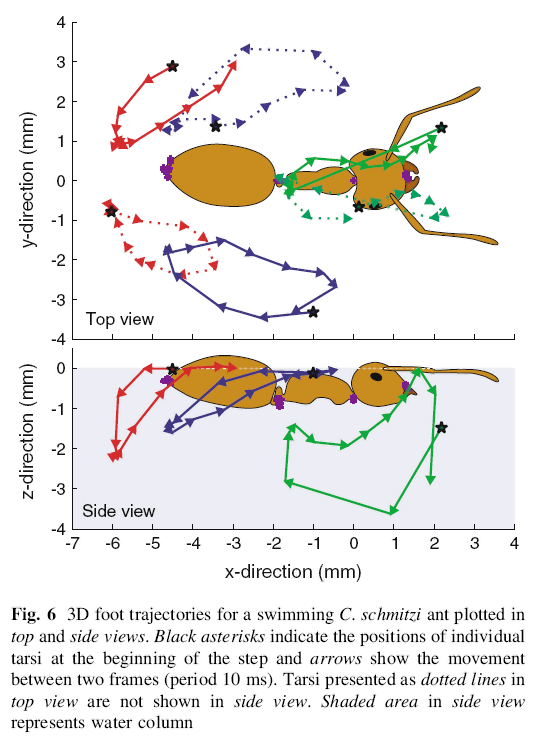
Плавание муравьёв в кувшинчиках непентеса

***
"Insectes sociaux", Муравьиные НОВОСТИ: Виды-2011 и 2012,
Статьи-2008 и 2012
 Термиты на кувшинчике Nepenthes (по: www.biozentrum.uni-
wuerzburg.de)
Термиты на кувшинчике Nepenthes (по: www.biozentrum.uni-
wuerzburg.de)
|
Добавлено 10-05-2012
|
|
Исследован механизм плавания муравьёв в кувшинчиках непентеса: кинематика водной и наземной локомоции у муравья Camponotus schmitzi
|
|
Holger Florian Bohn1,2,
Daniel George Thornham1,
Walter Federle1
E-mail:
holger.bohn@biologie.uni-freiburg.de
wf222@cam.ac.uk
1 - Department of Zoology, University of Cambridge, Downing Street, Cambridge CB2 3EJ, UK
2 - Plant Biomechanics Group Freiburg, University of Freiburg, Schanzlestr. 1, 79104 Freiburg im Breisgau, Germany
Ants swimming in pitcher plants: kinematics of aquatic and terrestrial locomotion in Camponotus schmitzi
|
|

"J Comp Physiol A"
2012,
Volume 00, Number 4, Pages 1-12 (17 apr. 2012).
Journal of Comparative Physiology A: Neuroethology, Sensory, Neural, and Behavioral Physiology
|
|
|
Исследован механизм плавания муравьёв в кувшинчиках непентеса: кинематика водной и наземной локомоции у муравья Camponotus schmitzi. Ранее, в 2005 году я уже называл
это явление аквапланированием (В.К.).
Муравьи Camponotus schmitzi живут в симбиотических отношениях с растениями рода непентес с острова Борнео (Индонезия) вида Nepenthes
bicalcarata, имеющего ловчие листья-кувшинчики. Уникальные среди всех муравьёв, рабчие этого кампонотуса регулярно наряют и погружаются в
кувшинчики непентеса и плавают в его пищеварительном растворе собирая там корм для своего пропитания. С помощью высокоскоростной съёмки и
анализа движений было доказхано, что C. schmitzi плавают на поверхности с помощью всех шести погруженных ног, with an alternating
tripod pattern. Compared to running, swimming involves lower stepping frequencies and larger phase delays within the legs of each tripod.
Плавающие муравьи двигают передними и средними ногами быстрее and keep them more extended during the power stroke than during the return
stroke. Thrust estimates calculated from three-dimensional leg kinematics using a blade-element approach confirmed that forward propulsion is
mainly achieved by the front and middle legs. Задние ноги двигаются гораздо меньше, что говорит о их предназначении для регулирования.
Experiments with tethered C. schmitzi ants showed that characteristic swimming movements can be triggered by submersion in water. Эта
реакция отсутствовала в другого исследованного вида Camponotus. Данная работа демонстрирует как насекомые могут использовать сходные
локомоторные системы и сходные походки для движения по земле и в воде. Авторы обсуждают адаптации насекомых к aquatic/amphibious стилю жизни и
специальные адаптации муравьёв C. schmitzi к жизни на растении-хищнике, ловящем других насекомых в свои кувшинчике.
Key words: Nepenthes bicalcarata - Camponotus schmitzi - Insect-plant interaction - Swimming - Gait analysis .
Шёл, поскользнулся, упал ... в кувшинчик Непентеса… . (Bohn, 2004)
Обзор литературы по теме "муравьи-растения"
Мирмекофитизм

Рис.5. Кинематика локомоции муравья Camponotus schmitzi
(по: ©Bohn & al., 2012)
ВВЕДЕНИЕ.
Межвидовые отношения среди организмов могут приводить к облигатному симбиозу с невероятными специализациями партнеров.
Во многих взаимодействиях растения и насекомого биомеханические факторы играют важную роль. Леса и торфяные болота острова Борнео являются
родиной одной такой зависимости, где оба партнера приобрели захватывающие механическии адаптации.
Муравьи вида Camponotus schmitzi Starcke (Schuitemaker
and Staercke 1933) живут в симбиотических отношениях с хищным растением с ловчими листьями-кувшинчиками Nepenthes bicalcarata Hook. f.
Это растение одно из более чем 100 кувшинчиковых хищных растений, растущих в бедных по части питательных элементов условиях тропиков Старого
Света. Кувшинчики растений рода Nepenthes специализированы для привлечения, поимки и переваривания, главным образом членистоногой
добычи (Adam 1997).
Муравьи Camponotus schmitzi гнездятся эксклюзивно и только в полых усиках-стебельках кувшинчиков N. bicalcarata (Burbidge
1880; Clarke
and Kitching 1995). They feed on nectar secreted from the
peristome and on prey items captured by their host plant,
which they haul out of the pitcher fluid (Clarke and
Kitching 1995; Merbach et al. 1999). In striking contrast to
other ants which are regularly captured and digested in the
pitchers of N. bicalcarata, C. schmitzi ants are able to run
safely across the wet and slippery pitcher mouth (peristome)
and never become trapped (Clarke and Kitching
1995). Moreover, they forage for food inside the pitchers.
Highly unusually for ants, they are able to dive and swim in
the pool of digestive pitcher fluid. On their foraging trips,
they repeatedly enter and leave the fluid, apparently unaffected
by surface tension forces.
Несмотря на заметность этого взаимодействия растения и муравья,
биомеханические адаптации, позволяющие этому муравью процветать в этих экстремальных условиях обитания, не были исследованы.
Here we focus on the ants’ unique swimming behavior.
Unlike many aquatic insects, C. schmitzi ants do not possess
any apparent morphological adaptations for swimming
and they are also very agile runners on land, both suggesting
a relatively recent adaptation to the amphibious
lifestyle.
Плавание по поверхности воды как адаптация от случайного падения в воду или для crossing small water bodies has been
reported for several ant genera, including Camponotus
(DuBois and Jander 1985). While surface-swimming ants
generate thrust only by moving their front legs, with the
middle and hind legs acting as a rudder at the water surface,
the swimming behavior of C. schmitzi ants is different
in that it involves movements of all legs under water.
Here we report field and laboratory observations on the
aquatic foraging behavior of C. schmitzi and present a
kinematic analysis of swimming locomotion in comparison
with normal (terrestrial) running. We investigate (1) how
gait patterns for swimming and running are related to each
other and whether a different locomotor program is used
for swimming, (2) whether swimming is a special adaptation
of C. schmitzi and (3) how swimming ants generate
thrust.

Рис.6. Кинематика локомоции муравья Camponotus schmitzi
(по: ©Bohn & al., 2012)
ДИСКУССИЯ.
Исследователи обнаружили, что рабочие муравьи C. schmitzi плавают with a stereotyped
tripod pattern similar to that used by many insects for
running on land (Hughes 1952). However, there were
characteristic differences between the leg kinematics of
swimming and running in C. schmitzi ants. C. schmitzi ants
vary velocity and leg extension between power and return
stroke to generate thrust. During the power stroke, the front
and middle legs were extended and moved rapidly whereas
in the return stroke they moved slower and were held closer
to the body. Similar asymmetries between power and
return strokes are widespread among swimming animals
(Alexander 1982). The hind legs contributed only little to
the overall thrust, suggesting that they mainly serve for
stabilization and steering.
В то время, как многие чрезвычайно адаптированные водные насекомые обладают вытянутыми телами и специализированными ногами, приспособленными
для гребли, никаких таких морфологических адаптаций не наблюдается у C. schmitzi.
However, in the range of low Reynolds numbers
relevant for the swimming of C. schmitzi (Re\120),
the drag-reducing effect of a streamlined body shape is
likely to be small (Vogel 1981).
Кинематические различия между плаванием и управлением, вероятно, основаны на различных моторных программах ног. Это может частично отражать
ограничения различных физических сред.
During running, the air allows
faster leg protraction than the denser water, but the ground
contact constrains the extension of the legs and limits the
duty factor in comparison to swimming. Legged locomotion
on land often requires that the insect’s center of gravity
lies within the tripod of the three legs on the ground (Ting
et al. 1994). Static stability in the absence of foot adhesion
requires that legs are on the ground for more than half the
time, corresponding to a duty factor of at least 0.5. This
constraint is relaxed during swimming, where the insect is
supported by water, making smaller duty factors possible.
Кроме возможного прямого влияния физических ограничений,
the leg movements are modified for running and
swimming in a segment-specific way, leading to characteristic
differences in leg orientation, leg extension and
duty factor. This indicates that there may indeed be different
pattern generators for the different joints of each ant
leg, which possess some flexibility and independence,
consistent with previous findings on the locomotion and
pattern generation in stick insects (BaЁssler and BuЁschges
1998).
Несмотря на the segment-specific modifications for running
and swimming, C. schmitzi ants produce a tripod-like
coordination between the legs for both types of locomotion.
The motor programme for each individual leg depends on
the interaction of central and coordinating influences, as
well as peripheral sensory input (providing information
about joint positions, movements and loads) (Graham
1985; BaЁssler and BuЁschges 1998; Cruse et al. 2009). The
sensory input for legs moving freely in water is obviously
very different from that experienced by legs during running.
This different sensory input may explain why tethered
C. rufifemur ants did not show any coordinated leg
movements underwater. The disposition and neuronal
ability of C. schmitzi ants to perform coordinated swimming
movements without any substrate contact thus
appears to be an adaptation to the ants’ amphibious lifestyle.
Our experiments also demonstrate that the swimming
movements in C. schmitzi can be triggered by submersion.
It is unclear whether the ants react to the submersion
itself (using mechanical, optical or physiological cues) or
whether the higher drag forces acting on the legs provide
the necessary sensory input to convert the erratic leg
movements performed in air to the coordinated gait
underwater.
Некоторые другие членистоногие показывают различные способы ломоции в/на воде и по земле.
The patterns of leg
coordination are in most cases different between aquatic/
neustic and terrestrial locomotion [например, водные жуки
(Hughes 1958), клопы (Bowdan 1978; Wendler et al.
1985), прямокрылые (Pfluger and Burrows 1978), пауки
(Barnes and Barth 1991)]. In some cases, intermediate
types of locomotion were found (such as intermediates
between walking and rowing in semi-aquatic spiders;
Barnes and Barth 1991), again suggesting that the different
movement patterns are produced by a flexible system
capable of generating variable patterns of motor output.
Способность быстро плавать даёт возможность муравьям C. schmitzi эксплуатировать содержание питчера (кувшинчика) как полезный источник
пищи.
The ants not only gain access to freshly captured, struggling
arthropods but they even succeed in capturing live
pitcher infauna such as rapidly swimming mosquito larvae
(Clarke and Kitching 1995).
Плавательное поведение что авторы наблюдали у муравья C. schmitzi has
several similarities to the surface-swimming behavior of
other ants, which was described in detail for Camponotus
americanus by DuBois and Jander (1985). First, most of
the thrust is produced by the front legs while the hind legs
move relatively little and are held in a backwards orientation.
Second, the front legs are extended during the power
stroke and flexed during the return stroke. In contrast to
C. americanus, however, C. schmitzi keeps all its legs
underwater continuously and both middle and hind legs
contribute to swimming by performing rhythmic motions,
although their movements are smaller than those of the
front legs. Moreover, the swimming movements of
C. schmitzi appear to be much faster (step frequency
9.35 Hz in C. schmitzi vs. 1.32 Hz in C. americanus,
DuBois and Jander 1985).
Плавание это сравнительно редкое поведение среди муравьёв,
обычно демонстрируемое только отдельными рабочими особями случайно упавшими в воду or when they actively cross
small bodies of water (DuBois and Jander 1985). Ant
species differ in their readiness to perform such surfaceswimming
behavior when dropped into water (W.F.,
personal observation). One exception in which swimming
is part of the normal behavioral repertoire is the specialized
mangrove-inhabiting species Polyrhachis sokolova
(Nielsen 1997; Attenborough 2005). In all these ants,
however, regardless of rarity of the behavior, the hind
legs are not submerged during swimming, but remain
dewetted at the surface of the water. This, taken together
with the 79 greater step frequency in C. schmitzi, indicates
a greater degree of specialization for its amphibious
lifestyle.
Таксономия крупного подрода Camponotus-subgenus
Colobopsis остаётся неразработанной (Brady et al. 2000) и ни одного близкого родственника у C. schmitzi до сих пор не найдено.
Однако, уникальность этой ассоциации между родами Nepenthes и Camponotus показывает, что это сравнительно недавнее эволюционное
достижение. This is consistent
with our finding that C. schmitzi uses a tripod
coordination for swimming, indicating a relatively simple
adaptation which may have required short evolutionary
periods. It appears that locomotion in water with a coordination
between the legs similar to walking and running
is common among terrestrial insects that only occasionally
swim (Shumakova et al. 2003), whereas many truly
aquatic insects have evolved more distinct ‘‘swimming
gaits’’ (see overview in Shumakova et al. 2003). It seems
plausible that the ancestors of C. schmitzi were able to
perform a surface-swimming behavior like C. americanus
and that further modifications were brought about by a
change in the surface chemistry of the cuticle, making the
legs more hydrophilic and allowing them to become submerged.
Such a change in surface chemistry would also
make it easier for C. schmitzi to enter the digestive fluid
when starting to forage inside a pitcher. Indeed, we have
preliminary evidence that the cuticle of C. schmitzi is
more wettable than that of other Camponotus ants (D.G.T.,
in preparation).
Адаптации муравьёв C. schmitzi к жизни в симбиозе с растением N. bicalcarata
не ограничивается способностью плавать в пищеварительных растворах его кувшинчиков. C. schmitzi is an obligate plant-ant, и его молодые
матки способны в конце брачного полёта определить местонахождение неколонизированных растений и прогрызать отверстие в домациях раздутых
усиков-стебельков кувшинчиков (Clarke and Kitching 1995). У C. schmitzi также есть превосходная способность прикрепляться к поверхности
перистома питчера-кувшинчика, даже когда она бывает скользкой и влажной (Bohn and Federle 2004). This not only
protects them against falling into the pitcher as many other
ants but it also allows them to search for prey and infauna
in the pitcher’s digestive fluid (Clarke and Kitching 1995).
Авторы этой работы в настоящее время исследуют захватывающую биомеханическую адаптацию C. schmitzi в его уникальной экологической нише.
Шёл, поскользнулся, упал ... в кувшинчик Непентеса… . (Bohn, 2004)
Составлена первая в мире карта сенсилл усиков у муравьёв.
Myrmica, Formica, Lasius, Pheidole и Camponotus
|
| |
|
|
|
|
| |
|
| |
-
Abdel-Aziz YI, Karara HM (1971) Direct linear transformation from
comparator coordinates into object space coordinates in closerange
photogrammetry. In: Proceedings of the Symposium on
Close-Range Photogrammetry, American Society of Photogrammetry,
Falls Church, VA, pp 1–18
-
Adam JH (1997) Prey spectra of Bornean Nepenthes species
(Nepenthaceae) in relation to their habitat. Pertanika J Trop
Agric Sci 20:121–134
-
Alexander RM (1982) Locomotion of animals. Blackie, Glasgow
-
Attenborough D (2005) Life in the undergrowth. In: Bassett P,
Salisbury M, Appleby B, Dunleavy S (eds) Life. BBC
-
Barnes WJP, Barth FG (1991) Sensory control of locomotor mode in
semi-aquatic spiders. In: Armstrong DM, Bush BMH (eds)
Locomotor neural mechanisms in arthropods and vertebrates.
Manchester Univ Press, Manchester, pp 105–116
-
Bassler U, Buschges A (1998) Pattern generation for stick insect
walking movements—multisensory control of a locomotor
program. Brain Res Rev 27:65–88
-
Bohn HF, Federle W (2004) Insect aquaplaning: Nepenthes pitcher
plants capture prey with the peristome, a fully wettable waterlubricated
anisotropic surface. Proc Natl Acad Sci USA
101:14138–14143
-
Bowdan E (1978) Walking and rowing in the water strider, Gerris
remigis. I. A cinematographic analysis of walking. J Comp
Physiol A 123:43–49
-
Brady SG, Gadau J, Ward PS (2000) Systematics of the ant genus
Camponotus (Hymenoptera: Formicidae) a preliminary analysis
using data from the mitochondrial gene cytochrome oxidase I.
In: Austin AD, Dowton M (eds) Hymenoptera. Evolution,
biodiversity and biological control. CSIRO Publishing, Collingwood,
pp 131–139
-
Burbidge FW (1880) Nepenthes bicalcarata. Gard Chron New Ser
13:264–265
-
Clarke CM, Kitching RL (1995) Swimming ants and pitcher plants: a
unique ant-plant interaction from Borneo. J Trop Ecol
11:589–602
-
Cruse H, Durr V, Schilling M, Schmitz J (2009) Principles of insect
locomotion. In: Arena P, Patane` L (eds) Spatial temporal
patterns for action-oriented perception in roving robots, vol 1.
Springer, Berlin, pp 43–96
-
Daniel TL (1984) Unsteady aspects of aquatic locomotion. Am Zool
24:121–134
-
DuBois MB, Jander R (1985) Leg coordination and swimming in an
ant, Camponotus americanus. Physiol Entomol 10:267–270
-
Ellington CP (1991) Aerodynamics and the origin of insect flight.
Adv Insect Physiol 23:171–210
-
Full RJ, Tu MS (1990) Mechanics of six-legged runners. J Exp Biol
148:129–146
-
Graham D (1985) Pattern and control of walking in insects. Adv
Insect Physiol 18:31–140
-
Hughes GM (1952) The co-ordination of insect movements I. The
walking movement of insects. J Exp Biol 29:267–284
-
Hughes GM (1958) The co-ordination of insect movements: III.
Swimming in Dytiscus, Hydrophilus and a dragonfly nymph.
J Exp Biol 35:567–583
-
Merbach MA, Zizka G, Fiala B, Merbach D, Maschwitz U (1999)
Giant nectaries in the peristome thorns of the pitcher plant
Nepenthes bicalcarata Hooker f. (Nepenthaceae): anatomy and
functional aspects. Ecotrop 5:45–50
-
Nielsen MG (1997) Nesting biology of the mangrove mud-nesting ant
Polyrhachis sokolova Forel (Hymenoptera, Formicidae) in
northern Australia. Insectes Soc 44:15–21
-
PfluЁger H-J, Burrows M (1978) Locusts use the same basic motor
pattern in swimming as in jumping and kicking. J Exp Biol
75:81–93
-
Schuitemaker JP, Staercke A (1933) Contributions a` l’eґtude de la
faune Nepenthicole. Art. III. Un noveau Camponotus de Borneo,
habitant les tiges creuses de Nepenthes. Natuurhistorisch
Maandblad 22:29–31
-
Shumakova I, Fursov V, Gladun D, Frantsevich L (2003) Swimming
in the diving wasp Prestwichia aquatica (Hymenoptera: Trichogrammatidae).
Entomol Gen 26:225–234
-
Ting LH, Blickhan R, Full RJ (1994) Dynamic and static stability in
hexapedal runners. J Exp Biol 197:251–269
-
Vogel S (1981) Life in moving fluids. Princeton University Press,
Princeton
-
Wendler G, Teuber H, Jander JP (1985) Walking, swimming and
intermediate locomotion in Nepa rubra. In: Gewecke M,
Wendler G (eds) Insect locomotion. Paul Parey, Berlin,
pp 103–110
-
Zollikofer CP (1994) Stepping patterns in ants I. Influence of speed
and curvature. J Exp Biol 192:95–106
|
| |
| |
|
©2012, Vladislav Krasilnikov (translation & supplement)
|
|
Всякое использование без согласования с автором и без активной гиперссылки на наш сайт
преследуется в соответствии с Российским законодательством об охране авторских прав.
|
|




